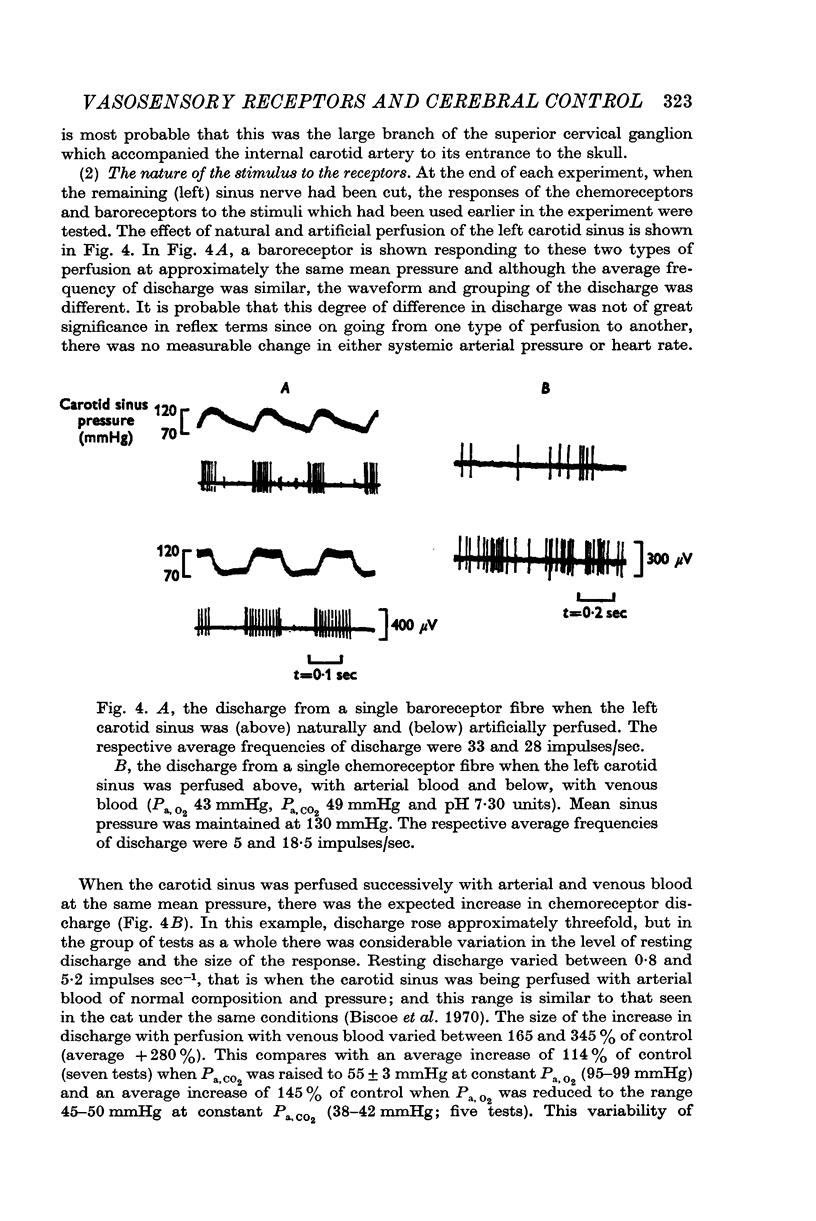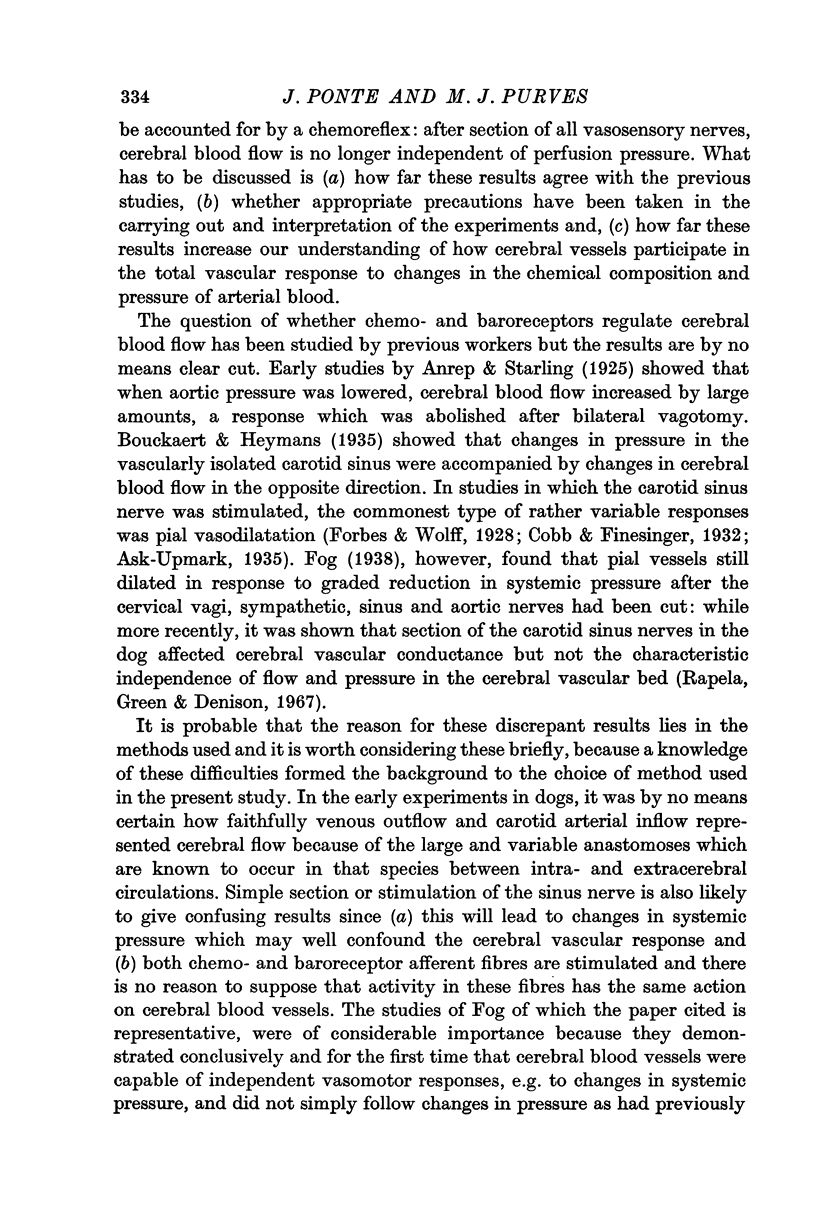Abstract
1. Cerebral blood flow was measured in 17 baboons, anaesthetized with pentobarbitone, paralysed with gallamine and mechanically ventilated and in which the right sinus and both aortic nerves had been cut and the left carotid sinus vascularly isolated. Later in each experiment, the head was artificially perfused with femoral arterial blood via the innominate artery.
2. Stimulation of the carotid body chemoreceptors with venous blood invariably caused a rise in regional cerebral blood flow whether the head was naturally or artificially perfused. This response was almost completely abolished if the VIIth cranial nerves were cut intracranially.
3. Regional cerebral blood flow varied inversely with carotid sinus pressure.
4. After the remaining (left) sinus nerve had been cut, the cerebral vascular response to hypoxia was negligible and the response to hypercapnia was markedly reduced. Blood flow then varied with perfusion pressure.
5. These results provide further evidence that cerebral blood vessels are reflexly controlled and that the peripheral arterial receptors are involved. Their action is most conspicuous in the vascular response to hypoxia and together with intrinsic factors in the cerebral vascular bed, they determine the size of the vascular response to changes in CO2 and pressure.
Full text
PDF

























Selected References
These references are in PubMed. This may not be the complete list of references from this article.
- Biscoe T. J., Bradley G. W., Purves M. J. The relation between carotid body chemoreceptor discharge, carotid sinus pressure and carotid body venous flow. J Physiol. 1970 May;208(1):99–120. doi: 10.1113/jphysiol.1970.sp009108. [DOI] [PMC free article] [PubMed] [Google Scholar]
- Bouckaert J. J., Heymans C. On the reflex regulation of the cerebral blood flow and the cerebral vaso-motor tone. J Physiol. 1935 Jul 24;84(4):367–380. doi: 10.1113/jphysiol.1935.sp003287. [DOI] [PMC free article] [PubMed] [Google Scholar]
- CUYPERS Y., KOVER G., NIZET A. [Neutralization of the vasoconstricting action of heparinized and preserved blood by different organs]. Arch Int Physiol Biochim. 1961 Mar;69:213–222. doi: 10.3109/13813456109092790. [DOI] [PubMed] [Google Scholar]
- D'Alecy L. G., Feigl E. O. Sympathetic control of cerebral blood flow in dogs. Circ Res. 1972 Aug;31(2):267–283. doi: 10.1161/01.res.31.2.267. [DOI] [PubMed] [Google Scholar]
- DAHL E., NELSON E. ELECTRON MICROSCOPIC OBSERVATIONS ON HUMAN INTRACRANIAL ARTERIES. II. INNERVATION. Arch Neurol. 1964 Feb;10:158–164. doi: 10.1001/archneur.1964.00460140044007. [DOI] [PubMed] [Google Scholar]
- Hoedt-Rasmussen K., Sveinsdottir E., Lassen N. A. Regional cerebral blood flow in man determined by intra-arterial injection of radioactive inert gas. Circ Res. 1966 Mar;18(3):237–247. doi: 10.1161/01.res.18.3.237. [DOI] [PubMed] [Google Scholar]
- Iwayama T., Furness J. B., Burnstock G. Dual adrenergic and cholinergic innervation of the cerebral arteries of the rat. An ultrastructural study. Circ Res. 1970 May;26(5):635–646. doi: 10.1161/01.res.26.5.635. [DOI] [PubMed] [Google Scholar]
- Iwayama T. Ultrastructural changes in the nerves innervating the cerebral artery after sympathectomy. Z Zellforsch Mikrosk Anat. 1970;109(4):465–480. doi: 10.1007/BF00343962. [DOI] [PubMed] [Google Scholar]
- James I. M., Millar R. A., Purves M. J. Observations on the extrinsic neural control of cerebral blood flow in the baboon. Circ Res. 1969 Jul;25(1):77–93. doi: 10.1161/01.res.25.1.77. [DOI] [PubMed] [Google Scholar]
- Kajikawa H. Mode of sympathetic innervation of the cerebral vessels demonstrated by the fluorescent histochemical technique in rats and cats. Nihon Geka Hokan. 1969 Mar 1;38(2):227–235. [PubMed] [Google Scholar]
- LEE K. D., MAYOU R. A., TORRANCE R. W. THE EFFECT OF BLOOD PRESSURE UPON CHEMORECEPTOR DISCHARGE TO HYPOXIA, AND THE MODIFICATION OF THIS EFFECT BY THE SYMPATHETIC-ADRENAL SYSTEM. Q J Exp Physiol Cogn Med Sci. 1964 Apr;49:171–183. doi: 10.1113/expphysiol.1964.sp001717. [DOI] [PubMed] [Google Scholar]
- Mchedlishvili G. I., Nikolaishvili L. S. Evidence of a cholinergic nervous mechanism mediating the autoregulatory dilatation of the cerebral blood vessels. Pflugers Arch. 1970;315(1):27–37. doi: 10.1007/BF00587234. [DOI] [PubMed] [Google Scholar]
- Purves M. J., James I. M. Observations on the control of cerebral blood flow in the sheep fetus and newborn lamb. Circ Res. 1969 Dec;25(6):651–667. doi: 10.1161/01.res.25.6.651. [DOI] [PubMed] [Google Scholar]
- Purves M. J. The effect of hypoxia, hypercapnia and hypotension upon carotid body blood flow and oxygen consumption in the cat. J Physiol. 1970 Aug;209(2):395–416. doi: 10.1113/jphysiol.1970.sp009171. [DOI] [PMC free article] [PubMed] [Google Scholar]
- Rapela C. E., Green H. D., Denison A. B., Jr Baroreceptor reflexes and autorregulation of cerebral blood flow in the dog. Circ Res. 1967 Oct;21(4):559–568. doi: 10.1161/01.res.21.4.559. [DOI] [PubMed] [Google Scholar]
- Raper A. J., Kontos H. A., Wei E. P., Patterson J. L., Jr Unresponsiveness of pial precapillary vessels to catecholamines and sympathetic nerve stimulation. Circ Res. 1972 Aug;31(2):257–266. doi: 10.1161/01.res.31.2.257. [DOI] [PubMed] [Google Scholar]
- SAGAWA K., GUYTON A. C. Pressure-flow relationships in isolated canine cerebral circulation. Am J Physiol. 1961 Apr;200:711–714. doi: 10.1152/ajplegacy.1961.200.4.711. [DOI] [PubMed] [Google Scholar]
- Shalit M. N., Shimojyo S., Reinmuth O. M. Carbon dioxide and cerebral circulatory control. I. The extravascular effect. Arch Neurol. 1967 Sep;17(3):298–303. doi: 10.1001/archneur.1967.00470270076009. [DOI] [PubMed] [Google Scholar]
- ZIERLER K. L. EQUATIONS FOR MEASURING BLOOD FLOW BY EXTERNAL MONITORING OF RADIOISOTOPES. Circ Res. 1965 Apr;16:309–321. doi: 10.1161/01.res.16.4.309. [DOI] [PubMed] [Google Scholar]


